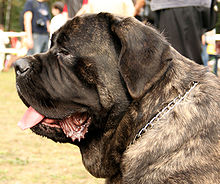Dewlap
This article includes a list of general references, but it lacks sufficient corresponding inline citations. (August 2011) |

A dewlap is a longitudinal flap of skin that hangs beneath the lower jaw or neck of many vertebrates. While the term is usually used in this specific context, it can also be used to include other structures occurring in the same body area with a similar aspect, such as those caused by a double chin or the submandibular vocal sac of a frog. In a more general manner, the term refers to any pendulous mass of skin, such as a fold of loose skin on an elderly person's neck, or the wattle of a bird. Dewlaps can be considered as a caruncle, defined as 'a small, fleshy excrescence that is a normal part of an animal's anatomy'.[1]
Mammals

Many mammals such as dogs, rabbits and moose possess dewlaps. In zebu cattle, the dewlap is colloquially known as the "briefcase folds".[citation needed] The dewlap is also found on female rabbits, such as the New Zealand white rabbit. While pregnant, the female rabbit will pluck fur from the dewlap to line a nest for her babies. Although these masses can be referred to as dewlaps, they are formed by stored fat. The dewlap is also seen in both sexes of moose.
Reptiles and birds
Many reptiles have dewlaps, most notably the anole species of lizard, which have large skin dewlaps which they can extend and retract. These dewlaps are usually of a different color from the rest of their body and when enlarged they make the lizard seem much bigger than it really is, used primarily when indicating territorial boundaries and for males to attract females during the mating season. Lizards which have mobile dewlaps usually accompany their dewlap movement with head bobs and other displays. Though much uncertainty resides around the purpose of these displays, the color of the dewlap and the head bobs are thought to be a means of contrasting background noise.
Many birds also have dewlaps, such as domestic chickens, some cracids and some guans.
See also
References
- ^ Lexic.us. "Definition of caruncle". Retrieved April 20, 2013.
- Weldon Owen Pty Ltd. (1993). Encyclopedia of animals - Mammals, Birds, Reptiles, Amphibians. Reader's Digest Association, Inc. ISBN 1-875137-49-1.
External links
 Media related to Dewlaps at Wikimedia Commons
Media related to Dewlaps at Wikimedia Commons
